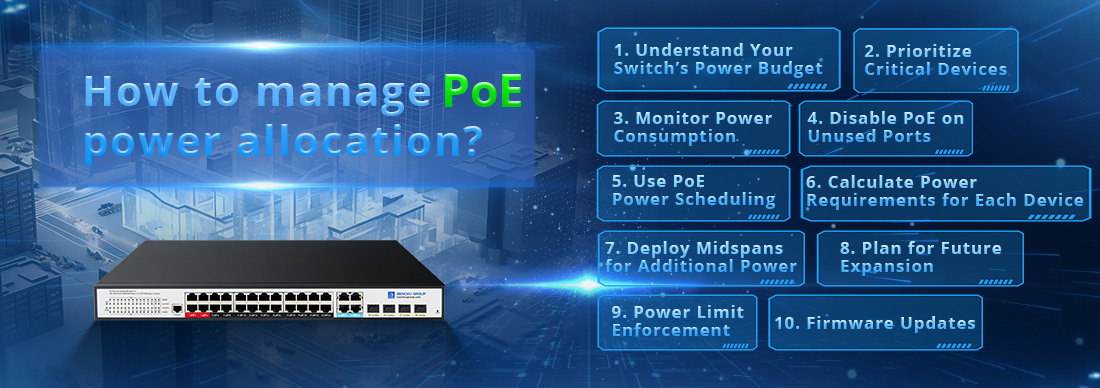
Managing PoE power allocation is essential for ensuring that your PoE-enabled switches provide sufficient power to connected devices without exceeding the switch's total power budget. Here’s a guide to help you efficiently manage PoE power allocation:
1. Understand Your Switch’s Power Budget
Total Power Budget: Check the total PoE power budget of the switch. This is the maximum amount of power the switch can supply to all connected devices.
Per-Port Power Limits: Ensure you know the maximum power each individual port can provide, especially if you are using high-power devices like PoE++ access points.
2. Prioritize Critical Devices
Set Power Priorities: Most managed PoE switches allow you to assign priority levels to different ports (e.g., low, medium, high). This ensures critical devices (like IP cameras or access points) receive power even if the power budget is exceeded.
Reserve Power for Critical Devices: Allocate more power to essential devices to ensure uninterrupted service.
3. Monitor Power Consumption
PoE Power Monitoring: Use the switch’s management interface (usually web-based or through CLI) to monitor the power usage of each port in real-time. This helps prevent overloading.
View Historical Data: Some switches can show historical power usage, allowing you to adjust the configuration if you notice consistent spikes or high demand.
4. Disable PoE on Unused Ports
Disable PoE on Inactive Ports: Turn off PoE on ports that are not in use to conserve the power budget for active devices. This can be done through the switch’s interface.
Automatic Port Detection: Some switches automatically disable PoE on unused ports, while others may need manual configuration.
5. Use PoE Power Scheduling
Time-Based Power Allocation: Some managed PoE switches allow you to schedule when certain ports deliver power. This can be useful for non-critical devices that don’t need to be powered 24/7, like access points in non-office hours.
Reduce Idle Power Draw: Use scheduling features to optimize power delivery based on operational hours.
6. Calculate Power Requirements for Each Device
Match Device Power Needs to PoE Standard: Ensure you know the exact power needs of each connected device and match them to the appropriate PoE standard. For example:
--- PoE (IEEE 802.3af): Up to 15.4W
--- PoE+ (IEEE 802.3at): Up to 30W
--- PoE++ (IEEE 802.3bt Type 3): Up to 60W
--- PoE++ (IEEE 802.3bt Type 4): Up to 100W
Avoid Overprovisioning: Don’t allocate more power than needed for lower-powered devices, which can deplete the switch’s overall power budget.
7. Deploy Midspans for Additional Power
Use PoE Injectors or Midspans: If your switch’s PoE power budget is insufficient for all connected devices, consider using PoE injectors or midspan devices to provide power to devices that require more than the switch can supply.
8. Plan for Future Expansion
Allow Room in the Power Budget: Always leave extra capacity in the power budget for future devices. Over-utilizing the power budget can lead to issues if more devices are added later.
Modular Switches: Consider modular switches with expandable PoE budgets for future-proofing your network.
9. Power Limit Enforcement
Enforce Maximum Power Limits: Some PoE switches allow you to enforce per-port power limits, preventing individual devices from drawing more power than intended. This is particularly useful for managing high-power PoE++ devices and ensuring other devices receive sufficient power.
10. Firmware Updates
Regular Firmware Updates: Ensure the switch firmware is up to date. New firmware versions often improve PoE power management features and resolve issues related to power allocation.
By following these steps, you can efficiently manage PoE power allocation, ensuring all devices receive the necessary power without overloading the switch. Regular monitoring and proactive configuration adjustments are key to optimizing PoE performance in your network.